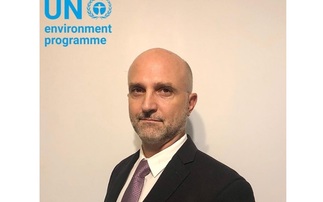
Ahead of tomorrow's Net Zero Festival, Toby Hill explores how carbon offset standards are evolving in a bid to assure clients and campaigners that promised carbon savings can be delivered
To find out more about the role of carbon offsets in the net zero transition, sign up now for a free pass to tomorrow's Net Zero Festival.
According to recent archaeological findings, humans' direct ancestors harnessed fire and may have used it to cook food around a million years ago. But today, nearly three billion people still use polluting and dangerous fuels to cook their food. Providing these households with clean cookstoves can both eliminate carbon emissions and catalyse progress towards a raft of other development goals, including improved health, nutrition, education, and gender equality.
Over the past five years, charities distributing clean cookstoves have hit on a major new vein of funding: carbon offsets, which see individuals or companies invest in projects to compensate for their own carbon footprints. Earlier this year, for example, Shell struck a deal which will see three million clean cookstoves distributed across East Africa.
This huge initiative - which Shell claims will benefit seven million people in Malawi, Zambia, Zimbabwe, Mozambique, Uganda, and Kenya - is expected to generate 60 million carbon credits for the energy giant. These credits will play a variety of roles within Shell's evolving net zero strategy, from enabling the energy giant to offer "carbon neutral" tariffs, to selling them on to other firms.
The scale of this project indicates the buoyant state of the market in carbon offsets, whose green shoots are poised for a period of explosive growth. Estimated to be worth around $600m in 2019, recent analysis from German bank Berenberg predicted that by 2050 the market could top $200bn - some experts believe this could prove to be a sizeable underestimate.
Last year, a taskforce was assembled to help both nurture and catalyse this growing market. Led by former Bank of England governor Mark Carney - who has called offsetting "an enormous green investment opportunity" - it brings together figures from some of the world's biggest corporations, including easyJet, Shell, Nestlé, and BlackRock, with carbon market specialists such as Verra also involved.
"Things are picking up in a very large way," says Robin Rix, chief policy and markets officer at Verra, a standard-setter that certifies offsetting projects. "We're seeing a huge number of major corporate commitments coming online."
For all his enthusiasm, Rix is quick to emphasise that "offsetting is not the primary solution" to the climate crisis. "We absolutely call for larger reductions, which have to come first," he stresses. But, he also argues that carbon offsets offer an "indispensable transitional mechanism" in those areas where it is not yet possible to achieve direct emissions reductions.
"Airlines can't refleet overnight," Rix reflects. "Not everyone can get rid of their gas-powered car overnight. We can't shut every factory down overnight. Offsetting offers a bridge between where we are now the world we want to reach." To date, Verra has accredited more than 1,700 projects, ranging from the Shell cookstoves initiative to a conservation scheme that safeguards a swathe of richly biodiverse rainforest in the Peruvian Amazon.
On the face of it, channelling vast flows of cash from the world's richest companies into conservation and community-based projects in the Global South can only be a good thing. But not everyone is convinced that the promised environmental benefits will materialise - and some warn that, in the context of a fast-worsening climate change, attempts to scale up offsetting could do more harm than good.
"The scheme risks being a huge exercise in greenwash, providing get out of jail free cards for polluting companies who wish to avoid the hard work of eliminating their own fossil fuel use," Greenpeace warned in a briefing note on the Carney-led Taskforce earlier this year. At the same time, 41 scientists published an open letter insisting that "we must reject offsetting", arguing governments and businesses should instead prioritise "climate financing" and operating within "a limited carbon budget".
In sharp contrast to climate sceptics, offset sceptics do not lack evidence to back up their stance. In 2008, the UN launched a carbon trading mechanism named Joint Implementation (JI), under the auspices of the Kyoto Protocol. Seven years later, a damning analysis concluded that JI had "enabled global GHG emissions to be about 600 million tonnes of carbon dioxide equivalent (tCO2e) higher than they would have been" if countries had prioritised cutting emissions instead of purchasing offsets.
Nor was this just a result of flaws within the specific design of JI. A second UN trading scheme, the Clean Development Mechanism (CDM), was similarly dogged by controversy and accusations of underperformance. A European Commission study found that 85 per cent of CDM projects had "a low likelihood of ensuring environmental integrity (i.e. ensuring that emission reductions are additional and not over-estimated)". Incredibly, the study found that just two per cent of the projects had "a high likelihood of ensuring environmental integrity".
These striking figures immediately cast doubt on Carney's optimistic views on the role offsetting can play in tackling climate change. "That's the biggest concern: that all the emphasis in the Carney initiative is on scaling a market that could be selling a terrible product," warns Charlie Kronick, Greenpeace's climate finance advisor.
For some analysts, such flaws are hard-wired into the concept of offsetting itself. "Offsetting allows the continuation of delay," argues Duncan McLaren, a Professor in Political Ecology at the University of Lancaster's Environment Centre, where he studies the "mitigation deterrence effects of greenhouse gas removals".
"The argument is that if you can't make cuts now, then putting in place offsets is better than not doing anything," McLaren continues. "But if that assuages your shareholders, or reduces public concern, and so reduces pressure on you to deliver emission reductions at source, it can do more harm than good."
This risk is made worse, McLaren argues, by inherent flaws in the economic logic behind offsetting. "There's an assumption of fungibility: that a ton of carbon is equal, wherever it comes from and wherever it's going," he says. But whereas burning a ton of carbon that is locked up in a fossil fuel will definitely see that carbon released into the atmosphere, the same certainty simply is not present in most offsetting schemes. This is particularly true in the context of nature-based solutions, which involve complex interconnected ecosystems combined with uncertainties over what will happen to the sequestered carbon in the future - or what might have happened had the offset project never taken place. Most notably, what happens if a new forest developed using carbon offset funding burns down in a climate-induced wildfire?
To understand these risks and complexities, it is worth considering a raft of recent studies which have uncovered a pervasive tendency to overstate the carbon savings achieved by forest conservation projects. A recent Bloomberg Green investigation, for example, accused the Nature Conservancy of dramatically exaggerating the level of threat to existing forests in order to generate additional carbon credits. Similar misrepresentations were identified in offsetting projects offered by the National Audubon Society in South Carolina, which claimed to be providing urgently needed protection to trees in an ancient forest - some of which had stood untouched for a thousand years.
Parallel problems have been highlighted in schemes verified by Verra. A 2020 PNAS study considered 12 forest conservation projects in the Brazilian Amazon. As in the cases above, turning such projects into measurable offsets is a technical challenge: it involves establishing a baseline scenario - what the deforestation rate would have been in the absence of any offsetting project - and from that calculating how many trees (and therefore how much carbon) the project will save. On launching the scheme, Verra's methodology had assumed that, in total, the projects would save just under 25 million tonnes of carbon. Following up several years later, the PNAS study compared these project areas with a series of control groups in which no such offsetting had taken place. It found that, in 11 of the 12 case studies, there was no difference whatsoever in the deforestation rate. Even in the one project that did reveal a difference, researchers concluded that 40 per cent of the claimed emission savings were overstated.
Rix counters that the study's findings were "problematic", and overreliant on simple, sweeping assumptions about counterfactual scenarios that are, by definition, challenging to establish. "The reality is that measuring specifically how much carbon is saved may be difficult, but we know intuitively that standing forest will sequester forest while felled forest does not," he argues. "We should never let the best be the enemy of the good." Advocates of offsets issued for forest protection projects would argue that in a world where deforestation loss is continuing and the planet continues to lose forest cover at a worrying rate, funding forest protection schemes has to be a welcome step forward.
Another leading carbon offset certifier, Gold Standard, has opted for an alternative approach for addressing concerns over such projects and does not accredit forest conservation projects. "It's of course critical to protect forests, and financial institutions should be helping do that," says Sarah Leugers, communications director at Gold Standard. "But because of the technical complexity, we don't think carbon credits are the right tool to achieve this - we need new tools to protect forests."
However, other research has suggested that it is not just forest conservation projects that struggle to demonstrate what is termed "additionality" - i.e., that the carbon savings were a direct result of the offsetting project and would not have occurred in its absence. Last year, a Finnish non-profit named Compensate embarked on an in-depth review of the current offsetting market. Gathering a team of leading climate scientists, it asked them to design a set of criteria against which projects could be assessed. It then used this criteria to evaluate "top-tier projects certified by either Verra or Gold Standard", laying out its findings in a detailed white paper.
"We found that 90 per cent of the projects failed to meet our scientists' criteria," explains Niklas Kaskeala, head of sustainability at Compensate. "Of this 90 per cent, 50 per cent of the projects failed to provide any additionality whatsoever."
Both Verra and Gold Standard questioned the definition of additionality used by Compensate in its study. Both also said they had tightened their own criteria since certifying many of the projects Compensate's study had evaluated. Gold Standard, for example, recently introduced a follow-up "additionality" assessment at five years into a project's life-cycle, at which point it must again demonstrate an ongoing financial need if it is to continue issuing credits.
Furthermore, in response to the increasing cost-competitiveness of renewable energy, Gold Standard last year ceased to register renewable energy projects based anywhere in the world except in the least-developed nations. Finally, the standard-setter also requires its projects to demonstrate impacts related to at least three Sustainable Development Goals, helping counteract criticisms, voiced by McLaren among others, that the current offsetting approach ignores the interconnected nature of the environmental crisis. Tweaks such as these, Leugers argues, provide a floor of environmental integrity for projects that is far higher than that which underlay the UN's JI or CDM programmes.
For all its criticisms of the current market, Compensate does believes that offsetting has a role to play in decarbonising the global economy. Accordingly, it also offers accredited offset projects - taking two distinct steps to ensure their quality.
Firstly, it over-compensates for the inherently imprecise nature of carbon credits. "We don't believe that one carbon credit is really worth one ton of CO2," Kaskeala explains. "So we determine through our project evaluation criteria a more reliable estimate of the value of each project credit: our portfolio has estimates that range between 200kg and 700kg." It then pools together different projects types, diversifying each credit in order to minimise the risk of overstating its impact on emissions.
Solutions such as these, generated by the standard-setters themselves, provide a blueprint that businesses can follow when designing their own offsetting strategies - steering a course past unscrupulous providers and accusations of greenwash. As demand for offsets grows, however, the challenge will lie not just in finding quality offsets, but in embedding these practices throughout the market as a whole.
"My fear is that, as it grows, the market will become polarised: on the one hand we have good quality credits and buyers willing to pay for them, and on the other, low-quality cheaper credits," Kaskeala says. Such a proliferation of low-quality credits risks corroding the credibility of offsetting altogether, he adds.
Preventing this situation is one of the tasks assigned to the Carney Taskforce, which recently proposed establishing a set of "Core Carbon Principles" along with a governing body to enforce them. Ensuring that these regulatory structures are sufficiently rigorous to maintain the offset market's credibility is a task that businesses can join both the standard setters such as Verra, Gold Standard, and Compensate, and civil society groups like Greenpeace, in undertaking. Given the technical difficulties of achieveing absolute zero emissions, any business with a net zero target has an interest in the development of a market that can deliver real world 'negative emissions'.
After years of false starts and failings, it seems that the hard work of making carbon offsetting a force for environmental good is only just beginning.
To find out more about the role of carbon offsets in the net zero transition, sign up now for a free pass to tomorrow's Net Zero Festival.







